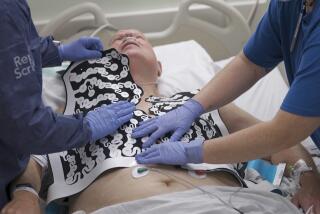A New Procedure Zaps Cancer of Liver, at Least Temporarily
- Share via
A diagnosis of cancer is bad enough, but news that it has spread to the liver has always been cataclysmic.
Few people survive for five years once cancer is detected in the liver, most living on borrowed time if they celebrate two more Christmases or birthdays.
But a new technique for zapping liver tumors is turning back--if not stopping--the clock.
The procedure uses heat to literally burn tumors out of the liver. And though it is not for everyone, the process, called radiofrequency thermoablation, appears to be extending the lives of people who once had little hope.
“The three or four patients I’ve dealt with have been in their 30s,” said Dr. Guy R. Nicastri, a surgeon at Griffin Hospital in Derby, Conn. “They’re saying if you can buy me another year with my kids, it’s worth it.”
But not all candidates for the procedure are young. At Hartford Hospital one recent morning, Dr. John Straub, a radiologist, zapped a tumor in the liver of a 65-year-old woman whose cancer had spread from her stomach. She had her first ablation almost a year ago and had been cancer-free since then. She returned to the hospital in September after a routine CT scan revealed a small new growth in her liver.
“This is not a cure,” Straub said, noting that the woman’s second tumor was no surprise. “This is to prolong a person’s meaningful life.”
Liver cancer is deadly because the size and location of tumors make surgical removal possible in only 10% to 20% of patients. For the rest, doctors have tried to kill liver tumors by freezing them, injecting them with alcohol or poisoning them with conventional chemotherapy. But none of these attempts has significantly prolonged life.
The idea behind ablation is to zap out the offending tumors while leaving behind enough healthy liver tissue to digest food and rid the body of toxins. Doctors hope that by remaining one step ahead of the cancer, they can give patients a better chance at feeling better and living longer.
Like many liver cancer patients, Steven Grove’s liver tumors spread from his colon. About half of the 130,000 people who will be diagnosed with colon cancer in the United States this year also will have growths in their livers. And only a fraction of those liver tumors will be removable with surgery.
After chemotherapy failed to shrink his liver tumors, Grove, the father of an 8-year-old boy, turned to Nicastri.
Nicastri used a minimally invasive surgical approach to find the tumors on Grove’s liver and kill them with probes heated to just above 212 degrees Fahrenheit.
Nicastri said he prefers the laparoscopic approach, cutting inch-long incisions in the abdomen and inserting a telescope and an internal ultrasound probe to examine every inch of the liver’s surface. He said this approach allows him to find tumors that might not show up on CT or MRI pictures.
In Grove’s case, Nicastri planned to burn out four or five tumors and ended up zapping seven.
The probe also can be inserted through the skin directly into the liver using an ultrasound scanner on the surface of the abdomen to find the tumors. And some surgeons prefer to cut an incision in the abdomen to reach the liver.
Once the heating instrument is inside the liver, the process is the same.
The instrument resembles a long, thin soldering iron or a very thin curling iron, with the cooking elements concealed in the tip. Once the tip is inside the tumor, the doctor pushes a button, and a fountain of silver wires fans out like fireworks cascading from the sky. The wires vibrate and get very hot, killing tissue.
Though there is no consensus about how many tumors can be burned out, doctors generally agree that patients with fewer than six tumors, none bigger than a walnut, have the best chance of benefiting.
Straub, who inserts the probe through the skin to reach the tumors, prefers to treat patients with no more than four tumors, each no bigger than a half-dollar.
“We don’t want to put people through unnecessary things with false hope,” Straub said. One exception, he said, would be a patient with a large, incurable tumor that is causing pain.
Nicastri is somewhat more liberal about the number of tumors he’ll zap, but because it takes about a half-hour to cook each tumor, he agreed that doctors must be cautious about the number they can attack at once.
Though most liver cancers now spread from elsewhere, such as the colon, breast, stomach or endocrine system, the incidence of primary liver tumors is on the rise in the wake of the hepatitis C epidemic that began in the 1980s.
A liver transplant is the best hope for these patients, but a shortage of donated organs makes death almost inevitable for most of them.
Straub said it is possible that zapping tumors might keep some primary liver cancer patients alive long enough to wait for a new liver.
Though liver-zapping devices have been used in Europe for about six years and have been widely available in the United States for at least two years, only lately is the procedure catching the attention of cancer doctors.
One reason it has been slow to catch on is there has not yet been a clinical trial proving that liver zapping extends life for five years or more--considered the gold standard for cancer doctors.
In many cases, patients such as Grove have learned about the procedure on their own and demanded it.
“I want quality of life, and I want it for as long as possible,” said Grove, a 38-year-old accountant from Hamden, Conn.






